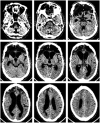The functional neuroanatomy of depression: distinct roles for ventromedial and dorsolateral prefrontal cortex - PubMed (original) (raw)
Review
The functional neuroanatomy of depression: distinct roles for ventromedial and dorsolateral prefrontal cortex
Michael Koenigs et al. Behav Brain Res. 2009.
Abstract
A primary aim in the neuroscientific study of depression is to identify the brain areas involved in the pathogenesis of symptoms. In this review, we describe evidence from studies employing various experimental approaches in humans (functional imaging, lesion method, and brain stimulation) that converge to implicate the ventromedial and dorsolateral sectors of prefrontal cortex as critical neural substrates for depression, albeit with distinct functional contributions. The putative roles of ventromedial and dorsolateral prefrontal cortex in depression are discussed in light of the results.
Figures
Figure 1
A. Depiction of vmPFC (in red) in midline views of each hemisphere. B. Depiction of dlPFC (in blue) in lateral views of each hemisphere.
Figure 2
Lesion overlaps of VHIS patients with bilateral vmPFC or dlPFC damage. Color indicates the number of overlapping lesions at each voxel. Top row: Axial slices of a normal healthy brain, for reference. Second row: Lesion overlap for the vmPFC lesion group. Third row: Lesion overlap for the dorsal PFC lesion group.
Figure 3
CT image (axial slices) of patient experiencing depression alleviation following suicide attempt. Ventral PFC is almost entirely destroyed, including vmPFC bilaterally (top row), whereas dorsal PFC is largely intact (bottom row).
Similar articles
- Distinct regions of prefrontal cortex mediate resistance and vulnerability to depression.
Koenigs M, Huey ED, Calamia M, Raymont V, Tranel D, Grafman J. Koenigs M, et al. J Neurosci. 2008 Nov 19;28(47):12341-8. doi: 10.1523/JNEUROSCI.2324-08.2008. J Neurosci. 2008. PMID: 19020027 Free PMC article. - Executive and prefrontal dysfunction in unipolar depression: a review of neuropsychological and imaging evidence.
Rogers MA, Kasai K, Koji M, Fukuda R, Iwanami A, Nakagome K, Fukuda M, Kato N. Rogers MA, et al. Neurosci Res. 2004 Sep;50(1):1-11. doi: 10.1016/j.neures.2004.05.003. Neurosci Res. 2004. PMID: 15288493 Review.
Cited by
- Disrupted emotion regulation and spontaneous neural activity in panic disorder: a resting-state fMRI study.
Wang HY, Guan BY, Wang SY, Ni MF, Miao YW, Tian F, Chen Y, Wu ML, Li R, Zhang BW. Wang HY, et al. Ther Adv Psychopharmacol. 2024 Nov 16;14:20451253241298871. doi: 10.1177/20451253241298871. eCollection 2024. Ther Adv Psychopharmacol. 2024. PMID: 39552918 Free PMC article. - What can the psychoneuroimmunology of yoga teach us about depression's psychopathology?
Chiarpenello C, Brodmann K. Chiarpenello C, et al. Brain Behav Immun Health. 2024 Sep 30;42:100877. doi: 10.1016/j.bbih.2024.100877. eCollection 2024 Dec. Brain Behav Immun Health. 2024. PMID: 39430877 Free PMC article. - Meta-analysis of resting-state fMRI in cervical spondylosis patients using AES-SDM.
Zhang Q, Ding H. Zhang Q, et al. Front Neurol. 2024 Sep 24;15:1439939. doi: 10.3389/fneur.2024.1439939. eCollection 2024. Front Neurol. 2024. PMID: 39381074 Free PMC article. - Unilateral vs. bilateral DLPFC rTMS: comparative effects on depression, visual-spatial memory, inhibitory control and cognitive flexibility in major depressive disorder.
Asgharian Asl F, Abbaszade S, Derakhshani H, Vaghef L, Asgharian Asl A. Asgharian Asl F, et al. Front Psychiatry. 2024 Sep 3;15:1400414. doi: 10.3389/fpsyt.2024.1400414. eCollection 2024. Front Psychiatry. 2024. PMID: 39290299 Free PMC article. - Cognitive Dysfunction in the Addictions (CDiA): A Neuron to Neighbourhood Collaborative Research Program on Executive Dysfunction and Functional Outcomes in Outpatients Seeking Treatment for Addiction.
Nikolova YS, Ruocco AC, Felsky D, Lange S, Prevot TD, Vieira E, Voineskos D, Wardell JD, Blumberger DM, Clifford K, Dharavath RN, Gerretsen P, Hassan AN, Jennings SK, Le Foll B, Melamed O, Orson J, Pangarov P, Quigley L, Russell C, Shield K, Sloan ME, Smoke A, Tang V, Cabrera DV, Wang W, Wells S, Wickramatunga R, Sibille E, Quilty LC; CDiA Program Study Group. Nikolova YS, et al. medRxiv [Preprint]. 2024 Oct 28:2024.08.30.24312806. doi: 10.1101/2024.08.30.24312806. medRxiv. 2024. PMID: 39252904 Free PMC article. Preprint.
References
- Davidson RJ, et al. Depression: perspectives from affective neuroscience. Annu Rev Psychol. 2002;53:545–74. - PubMed
- Drevets WC. Functional neuroimaging studies of depression: the anatomy of melancholia. Annu Rev Med. 1998;49:341–61. - PubMed
- Drevets WC. Orbitofrontal cortex function and structure in depression. Ann N Y Acad Sci. 2007;1121:499–527. - PubMed
- Kringelbach ML, Rolls ET. The functional neuroanatomy of the human orbitofrontal cortex: evidence from neuroimaging and neuropsychology. Prog Neurobiol. 2004;72(5):341–72. - PubMed
- Rosenkilde CE. Functional heterogeneity of the prefrontal cortex in the monkey: a review. Behav Neural Biol. 1979;25(3):301–45. - PubMed
Publication types
MeSH terms
LinkOut - more resources
Full Text Sources
Other Literature Sources
Medical


